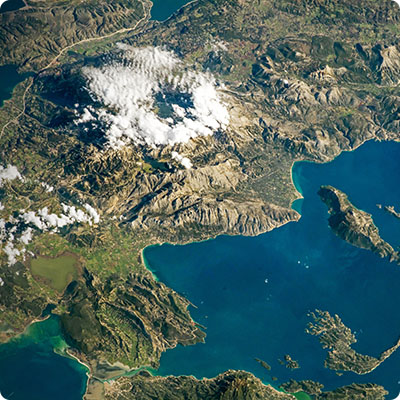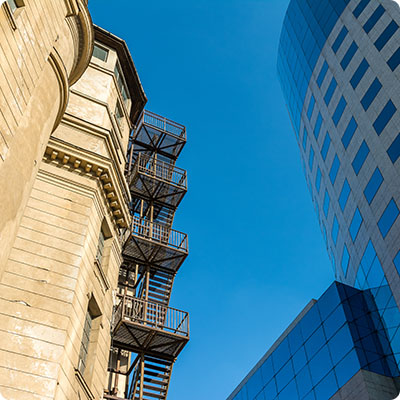Entre 40 000 et 52 000 av. J.-C. environ
The figurative rock paintings in the Lubang Jeriji Saléh caves, near Kutai (Kalimantan Timur), date from this period, according to a 2018 estimate by researchers. Previously connected to the Asian continent, the territory is thought to have been inhabited since the Lower Paleolithic, but this is the oldest trace of human presence in Borneo to date.
40 000 av. J.-C.
Rock paintings in the caves of Niah National Park (Sarawak), as well as a human skull found at the site dating from this period, attest to the fact that the region was inhabited before the arrival of the Austronesians.
20 000 av. J.-C.
Until the last glacial maximum, Borneo was connected to mainland Asia by a land mass forming the Sunda continental shelf. As the ice melted, sea levels rose, engulfing Sunda and separating the territory from the mainland. Borneo became an island.
4 000 av. J.-C.
Austronesians from the southern coast of China migrate across the Strait to Taiwan and begin to spread their culture and language.
Entre 4 000 et 2 500 av. J.-C.
Waves of Austronesian migration from Taiwan to the Philippines and the island of Sulawesi, near Borneo. The first great navigators of the Pacific Ocean, the Austronesians then settled on the island. They are the ancestors of Borneo's indigenous Dayak peoples.
IVe siècle
Stone pillars bearing inscriptions carved in Pallava script found at Kutai, demonstrating that trade with Hindu empires has been going on since at least the 4th century.
VIe siècle
Borneo, located on the major shipping routes between China, Indonesia, India and the Middle East, became a thriving maritime trading center.
IXe siècle
Islam first appeared on the island with the arrival of Muslim traders who landed on the coast of what is now the state of Sabah. They then converted many of the natives living along the coast. Over the following centuries, Borneo witnessed the emergence of Muslim sultanates that governed various territories on the island.
Xe siècle
Towns along the western seaboard became important trading ports. According to ancient Chinese manuscripts, precious commodities such as gold, camphor, birds' nests (a delicacy in Asia), rattan, noble woods and spices could be purchased here. Chinese ceramics dating back to the Tang dynasty (8th century), found in 1948 by the Briton Tom Harrison at Santubong, near Kuching, attest to trade between Borneo and China during this period.
Début du XIIIe siècle
The island's various sultanates supported each other in countering outside invaders. In his memoirs, Marco Polo mentions that Genghis Khan and his Mughal empire made several unsuccessful attempts to invade Borneo, then known in Europe as "Greater Java".
XIIIe siècle
Majapahit Empire
Founded in 1292, the Javanese kingdom of Majapahit, the most powerful empire of the Hindu-Buddhist period in Indonesia, based its power on domination of the Pacific Ocean. The capital of this thalassocracy was Troluwan, today Mojokerto in East Java, Indonesia. In the 14th century, Majapahit extended its influence over the Borneo coastline and the Bruneian Empire. The empire was at its height.
Fin du XIVe siècle
The Lupah Sug was an empire stretching from Palawan and the Sulu archipelago in the Philippines to Sabah and East Kalimantan. The Lupah Sug rebellion against the imperialist occupation of the Majapahit empire was the founding act of the Sultanate of Sulu in 1405, which succeeded in retaining the territories that today correspond to the Sabah coastline.
XIVe siècle
Bruneian Empire
Also known as the Sultanate of Brunei, this empire was founded in either 1338 or 1363, according to ancient Chinese texts. The absence of tangible evidence and indigenous written traces makes it impossible to date its foundation with any precision. Previously under the control of Java, Brunei emancipated itself and became a monarchy, headed by Sultan Muhammad Shah. The empire stretched along the northwest and northeast coasts of the island, corresponding to the coastlines of Sarawak, Brunei and Sabah today, and its capital was Kota Batu. After the capture of Malacca in Peninsular Malaysia in 1511, Brunei conquered the Santubong kingdom in Sarawak and extended its influence to the Kapuas river delta in Kalimantan. This period, ruled by Sultan Bolkiah, was the "golden age" of the Bruneian Empire, which also held territories in the Sulu and Manila archipelagos, and the area stretching from Sarawak to Banjarmasin. The Sultanate of Sulu and the Malay Sultanate of Sambas (in West Kalimantan) maintain close ties with the Bruneian Empire, and cross their dynasties to consolidate their power. The Sultan of Brunei also has authority over the sultans of Pontianak, Samarinda and Banjarmasin (Kalimantan).
1511
The capture of Malacca by the Portuguese enabled them to start trading with certain Bornean sultanates, and then with the Bruneian Empire from 1830 onwards. Despite the island's many natural riches, the Portuguese had no plans to conquer it. The British and Dutch, on the other hand, were beginning to set their sights on Borneo.
1578
In April, a Spanish expedition landed in Borneo, and the Spanish Empire came into conflict with several sultanates, including those of Brunei, Sulu and Maguindanao in the Philippines. Although the Spaniards failed to capture the Sultanate of Brunei, they did succeed in curbing its expansion. The Sultanate of Sulu took advantage of this to free itself from Brunei's influence and extend its thalassocracy to certain territories in northern Borneo. Central Borneo remains untouched by any form of royal or governmental control.
1599
Year of the foundation of the Sultanate of Sarawak, a Malay kingdom ruled by Sultan Tengah, Ibrahim Ali Omar Shah. He was assassinated in 1641, after a 42-year reign over Sungai Bedil (now Kuching) and the surrounding region. From then on, the Sultan of Brunei appointed local governors to administer Sarawak, before the sultanate was reunited with the Brunei Empire.
Début du XVIIe siècle
The English East India Company began trading with the Sultanate of Sambas in the south of the island in 1609, and the Dutch followed suit in 1644 with other small sultanates in the south. These exchanges laid the foundations for the future Anglo-Dutch conflict over Borneo..
XVIIe siècle
Regular clashes between native tribes rock the island's interior. The Iban, Kenyah and Kayan ethnic groups engage in violent battles to expand their respective territories.
1660 – 1673
Brunei Civil War
A dispute between Bongsu, son of Muhammad Ali, 13th sultan of the Bruneian Empire, and Muda Alam, son of Abdul Hakkul Mubin, over the outcome of a cockfight, escalates when Bongsu kills Muda Alam in an act of anger. To avenge his son's death, Abdul Hakkul Mubin assassinates Sultan Muhammad Ali and proclaims himself the 14th Sultan of Brunei. To calm the social climate, he appointed Muhyddin, Muhammad Ali's nephew, to the rank of Bendahara, a distinction equivalent to that of Prime Minister. Muhammad Ali's supporters convinced Muhyddin to rise up against Abdul Hakkul Mubin. In 1673, Abdul Hakkul Mubin was killed and Bendahara Muhyddin acceded to the throne, becoming the kingdom's 15th sultan. Muhyddin ceded Eastern Sabah to the Sultan of Sulu in gratitude for his support in the conflict. The influence of the Bruneian Empire begins to wane. Brunei loses territory in the Philippines to the Spanish and in southern Borneo to the Dutch.
XVIIIe siècle
Successive sultans led the Bruneian Empire, but they were unable to prevent the kingdom's decline, undermined by internal struggles over succession to the throne and inevitable regional political upheavals. The growing influence of the European colonial powers on the island was another factor in the Empire's decline, with trade routes impacted by the arrival of European merchants, weakening the economic power of Brunei and the other Bornean sultanates.
1761
The Sultanate of Sulu authorized Alexander Dalrymple, an officer of the English East India Company, to establish a trading post on Pulau Balambangan (an island in the state of Sabah). Despite several attempts, the initiative was a fiasco. Subsequently, the Dutch East India Company also tried to establish a trading post on Balambangan, but was forced to withdraw from the island in 1791.
XIXe siècle
European colonization of the island
When British and Dutch explorers first arrived in Borneo, they described the island as being populated by headhunters and cannibals, and navigation around the island as being particularly dangerous due to the heavy presence of pirate ships. In 1815, the Dutch tried again to establish contact and settled in the towns of Banjarmasin, Sambas and Pontianak. In 1842, Sultan Omar Ali Saifuddin II of Brunei gave the governance of Sarawak to British explorer James Brooke, appointing him Rajah in gratitude for his help in resolving the Dayak uprising against the rulers of the Sultanate of Brunei. In 1846, Brooke signed the Treaty of Labuan with Sultan Omar Ali Saifuddin II, making the island of Labuan a possession of the British Crown. The Iban people expand into Sarawak territory during the reign of the White Rajah dynasty.
1881
The North BorneoChartered Company, a private merchant company, was founded and obtained the right to trade and administer the territory of Sabah from the British government. In 1885, the British, German and Spanish governments sign the Madrid Protocol, a treaty that enables Spain to assert its power over the Sultanate of Sulu in the Philippines in exchange for abandoning its commercial and political ambitions in the North Borneo regions.
1888
The territory of Sabah became a British protectorate and the British North Borneo Company retained the right to administer the region. British expansion into the island's interior forces the 26th Sultan of Brunei, Hashim Jalilul Alam Aqamaddin, to sign a treaty of protection with Great Britain, but he retains his power over internal affairs. The Sultanate of Brunei thus became a British protectorate. The lack of manpower on the island to work on the plantations forced the British to encourage the immigration of Chinese, mainly Hakkas from Guangdong province. Indians were also recruited for key positions in various sectors, including Sikh policemen, renowned for their courage and loyalty to the Crown.
1906
Establishment of a British residence in Brunei, which continued until 1984. The discovery of oil by the Shell company in 1928 rapidly transformed this poor state into a prosperous kingdom.
1941
World War II and the Japanese occupation
Before the war, the island of Borneo was divided into five territories: four administered by the British (Sarawak, Brunei, Labuan and North Borneo), and the other major part of the island under the control of the Dutch East India Company. On December 8, 1941, the Dutch government-in-exile declared war on Japan. On December 16, Japanese forces landed at Miri (Sarawak). On January 8, 1942, the Japanese occupied Jesselton (now Kota Kinabalu). In January 1942, the American-British-Dutch-Australian Command is set up to coordinate Allied resistance in Southeast Asia. The Japanese occupied most of the island until 1945, with resistance concentrated mainly in the west and north of the island. During this period, bombing raids were frequent and several towns, such as Sandakan and Jesselton, were severely hit. The Japanese surrendered to Australian forces on September 10, 1945.
1945
Post-war and independence movements
North Borneo, under British military control since the end of the war, became a Crown Colony in 1946. Sandakan having been completely destroyed by massive bombing, Jesselton became the capital. In the same year, Sarawak also became a British colony. Anthony Brooke, who was to inherit the Rajah's throne, continued to assert his sovereignty. He was banished from government, sounding the death knell for White Rajah rule in Sarawak. The Sultanate of Brunei remained under British military administration. In Kalimantan, a major Indonesian independence movement emerges.
17 août 1945
Indonesia proclaims its independence, but the Dutch try to maintain control over the archipelago.
1948
Creation of the Republic of Malaya, a federation of 11 states on the Malay Peninsula under British protectorate.
27 décembre 1949
The Dutch officially recognize the independence of Indonesia, which becomes an independent republic.
1950
Kalimantan becomes a territory of the Republic of Indonesia.
1957
The Republic of Malaya gains independence from the British.
29 septembre 1959
First constitution of the Sultanate of Brunei, restoring the Sultan's power over the internal affairs of the small British protectorate.
1961
The Prime Minister of the Republic of Malaya expressed the wish to unite his country with the British colonies (Sarawak, North Borneo and Singapore) and the protectorate of Brunei. He met with refusal from the Indonesian and Philippine governments, as well as from nationalists on the island of Borneo.
1962
Sukarno, the first President of the Republic of Indonesia, strongly opposed the British presence in North Borneo, Sarawak and Singapore. He decided to send Indonesian soldiers to the island. This marked the beginning of the Indonesian-Malay confrontation, known in Indonesian as Konfrontasi . This conflict, which pitted the British-backed Republic of Malaya against the Indonesians, lasted until August 1966. This marked the abolition of the Constitution of the Sultanate of Brunei, and there was only one political party, the National Solidarity Party.
1963
The Republic of Malaya becomes the Federation of Malaysia, including the states of the Malay Peninsula, Sarawak, North Borneo (now called Sabah) and Singapore. The Philippine government continues to assert its right of sovereignty over the former Sultanate of Sulu, a territory to the east of Sabah.
9 août 1965
Singapore achieves independence from the Federation of Malaysia.
22 décembre 1967
Jesselton, the capital of Sabah, becomes Kota Kinabalu.
1981
Mahathir Mohamad was elected Prime Minister of Malaysia, a post he held until 2001. He was behind a number of major projects to modernize the country, including the famous Petronas Towers in Kuala Lumpur, the new capital Putrajaya and the Formula 1 racetrack.
1er janvier 1984
The Sultanate of Brunei declares independence, ceasing to be a British protectorate and joining ASEAN (Association of Southeast Asian Nations). The micro-state's oil resources enabled it to rapidly become an industrialized territory and then to prosper spectacularly.
16 avril 1984
Sabah cedes the Labuan archipelago to the Federation of Malaysia.
1997
Malaysia, hit by the great Asian currency crisis, adopted a protectionist policy that enabled its economy to recover faster than those of its Thai and Indonesian neighbors.
Octobre 2013
Introduction of Sharia law in the Sultanate of Brunei, the first country in Southeast Asia to introduce Islamic law.
8 mars 2014
A Boeing 777 flying from Kuala Lumpur to Beijing disappears in the middle of the Indian Ocean. International investigations have yet to discover what happened to the 290 passengers aboard flight MH370.
2019
The Sultan of Brunei Darussalam is tightening Sharia law, and Muslims guilty of adultery, sodomy and/or homosexual relations are now liable to the death penalty.
Août 2019
Indonesian President Joko Widodo announces his wish to move the Indonesian capital from Jakarta to Nusantara in East Kalimantan from 2024.















